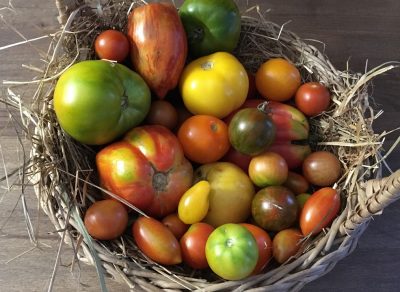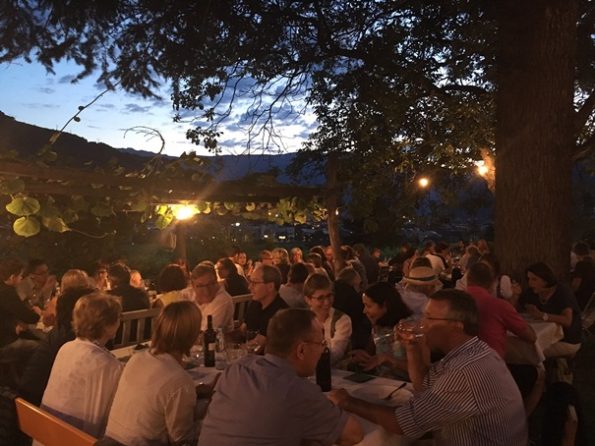 “You call those tomatoes?” The delicacies on our plates receive incredulous stares. We are standing in the middle of an incredibly beautiful landscape, surrounded by vineyards. The sun is just setting and swamps the scene in its golden light, while a small group of musicians accompany the joyful chatter of the guests seated on wooden benches. Picturesque would probably be a good word to describe the scenery – or maybe kitschy, depending on one’s mood. But all of it is a mere accessory for the main attraction of the evening: the tomato.
“You call those tomatoes?” The delicacies on our plates receive incredulous stares. We are standing in the middle of an incredibly beautiful landscape, surrounded by vineyards. The sun is just setting and swamps the scene in its golden light, while a small group of musicians accompany the joyful chatter of the guests seated on wooden benches. Picturesque would probably be a good word to describe the scenery – or maybe kitschy, depending on one’s mood. But all of it is a mere accessory for the main attraction of the evening: the tomato.
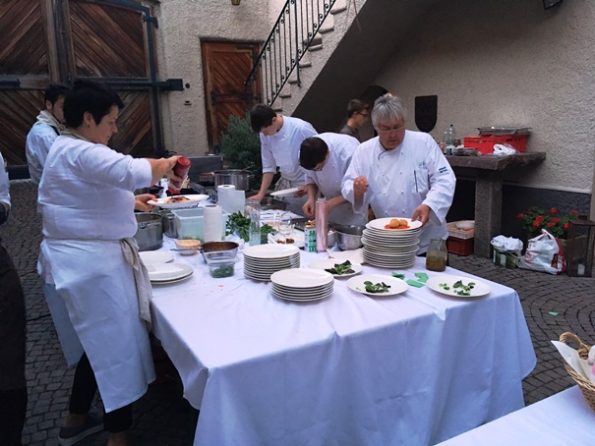 The opening of the season marks a reason for celebrating this fruit, which plays such an important role in most Europeans’ menu. The way to celebrate is a tomato feast, or as is called here “Paradeiserfest” (Paradeiser is a regional synonym for tomato) in the middle of South Tyrol at the Griesbauerhof winery. Star chefs Anna Matscher and Herbert Hintner, who support the Tumour Centre with many of their recipes, help the the tomato to put on its big performance. Tomatoes are served, for example, as a chocolate with yoghurt and sweet stewed tomatoes as core, as a tomato tiramisu or the classic tomato risotto.
The opening of the season marks a reason for celebrating this fruit, which plays such an important role in most Europeans’ menu. The way to celebrate is a tomato feast, or as is called here “Paradeiserfest” (Paradeiser is a regional synonym for tomato) in the middle of South Tyrol at the Griesbauerhof winery. Star chefs Anna Matscher and Herbert Hintner, who support the Tumour Centre with many of their recipes, help the the tomato to put on its big performance. Tomatoes are served, for example, as a chocolate with yoghurt and sweet stewed tomatoes as core, as a tomato tiramisu or the classic tomato risotto.
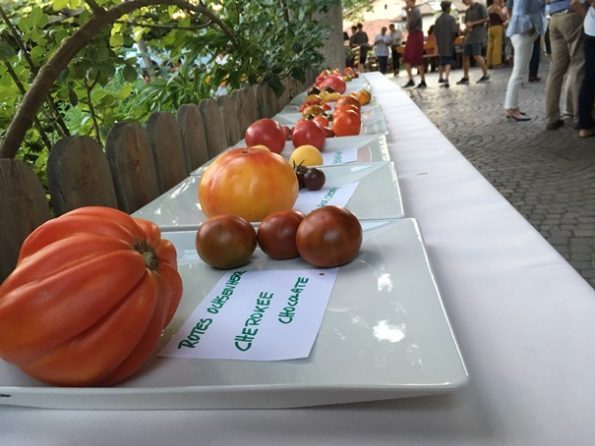 Apart from the preparation, the diversity of the traditional varieties which are used here, is particularly interesting. They bear beautiful names such as Black Heart, Coeur de Pigeon (pigeon heart), grüne Zebra-Cherry (green zebra cherry), Himmelsglück (“heavenly happiness”) or Miss Kennedy. Take one look at some of them and it becomes clear why the tomato in Italian is called “pomodoro” (golden apple). In contrast to the classical supermarket tomato, the ones here are snow-white, cream or golden yellow. But green and violet tomatoes can also be found in the most varied forms: smooth, ribbed, wrinkled, heart-shaped or hollow inside. It gradually becomes clear how long the route of the original tomato to us in Europe was from the Peruvian Andes via South and Central America.
Apart from the preparation, the diversity of the traditional varieties which are used here, is particularly interesting. They bear beautiful names such as Black Heart, Coeur de Pigeon (pigeon heart), grüne Zebra-Cherry (green zebra cherry), Himmelsglück (“heavenly happiness”) or Miss Kennedy. Take one look at some of them and it becomes clear why the tomato in Italian is called “pomodoro” (golden apple). In contrast to the classical supermarket tomato, the ones here are snow-white, cream or golden yellow. But green and violet tomatoes can also be found in the most varied forms: smooth, ribbed, wrinkled, heart-shaped or hollow inside. It gradually becomes clear how long the route of the original tomato to us in Europe was from the Peruvian Andes via South and Central America.
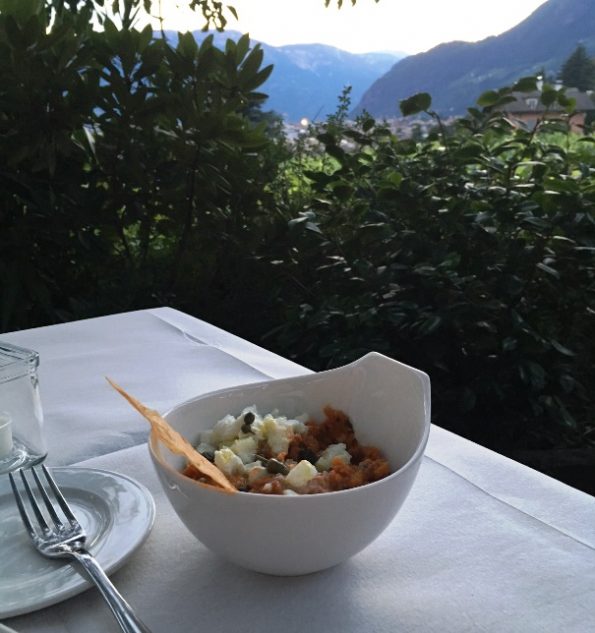 The constituents of the tomatoes such as carotenoids, polyphenols or vitamins, particularly lycopene, which is mentioned repeatedly in connection with prostate cancer, vary according to type. Here it is important to cut the tomato up small and heat it before eating it, so that the fruit cell can be broken up and the lycopene can be made more easily available. We have also explained more about cancer-relevant constituents of the tomato in an earlier blog contribution „Schützt Lycopin aus Tomaten tatsächlich vor Prostatakrebs?“.
The constituents of the tomatoes such as carotenoids, polyphenols or vitamins, particularly lycopene, which is mentioned repeatedly in connection with prostate cancer, vary according to type. Here it is important to cut the tomato up small and heat it before eating it, so that the fruit cell can be broken up and the lycopene can be made more easily available. We have also explained more about cancer-relevant constituents of the tomato in an earlier blog contribution „Schützt Lycopin aus Tomaten tatsächlich vor Prostatakrebs?“.
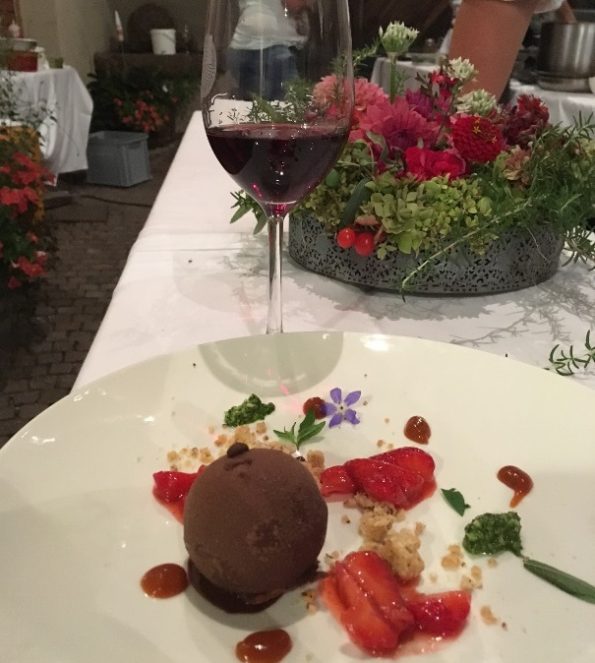 The variety of tomato types has been constantly reduced in the name of productivity and according to the ostensible wish of the consumer. Whereas the first European tomatoes were grown in a lot of colours, today they are mostly picked half-ripe in southern climes so that all year round they are available here red, and unfortunately full of water, in the supermarket. In spite of the interest of many consumers growing in the open air in Germany still has little significance. The danger of fungus diseases, burst fruit and fruit damaged otherwise on the exterior by rain and wind is too high. The amount of work needed is too high and the yield is too low.
The variety of tomato types has been constantly reduced in the name of productivity and according to the ostensible wish of the consumer. Whereas the first European tomatoes were grown in a lot of colours, today they are mostly picked half-ripe in southern climes so that all year round they are available here red, and unfortunately full of water, in the supermarket. In spite of the interest of many consumers growing in the open air in Germany still has little significance. The danger of fungus diseases, burst fruit and fruit damaged otherwise on the exterior by rain and wind is too high. The amount of work needed is too high and the yield is too low.
 When one looks at this plethora of variations and taste explosions one can only recommend very warmly to everyone to take up the search oneself and to delve for traditional tomato types outside the supermarket shelves. For all those who have now acquired the taste we have another small culinary gift next week. Michelin-star chef Anna Matscher has created two tomato recipes exclusively for the Munich Tumour Centre. Look forward to next Monday!
When one looks at this plethora of variations and taste explosions one can only recommend very warmly to everyone to take up the search oneself and to delve for traditional tomato types outside the supermarket shelves. For all those who have now acquired the taste we have another small culinary gift next week. Michelin-star chef Anna Matscher has created two tomato recipes exclusively for the Munich Tumour Centre. Look forward to next Monday!
